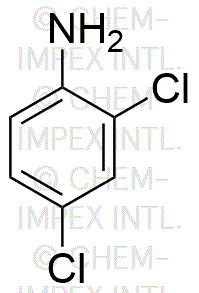2,4-Dichloroaniline is widely utilized in research focused on:
- Agricultural Chemicals: It serves as an intermediate in the synthesis of herbicides and pesticides, helping to improve crop yields and manage weeds effectively.
- Dyes and Pigments: This compound is used in the production of various dyes, providing vibrant colors for textiles and other materials, which is essential for the fashion and design industries.
- Pharmaceuticals: It plays a role in the development of pharmaceutical compounds, contributing to the creation of effective medications for various health conditions.
- Polymer Manufacturing: 2,4-Dichloroaniline is involved in the production of rubber and plastics, enhancing their properties and durability, which is crucial for automotive and construction applications.
- Analytical Chemistry: It is utilized as a reagent in laboratory analyses, aiding researchers in detecting and quantifying other chemical substances, thereby supporting quality control processes.
General Information
Properties
Safety and Regulations
Applications
2,4-Dichloroaniline is widely utilized in research focused on:
- Agricultural Chemicals: It serves as an intermediate in the synthesis of herbicides and pesticides, helping to improve crop yields and manage weeds effectively.
- Dyes and Pigments: This compound is used in the production of various dyes, providing vibrant colors for textiles and other materials, which is essential for the fashion and design industries.
- Pharmaceuticals: It plays a role in the development of pharmaceutical compounds, contributing to the creation of effective medications for various health conditions.
- Polymer Manufacturing: 2,4-Dichloroaniline is involved in the production of rubber and plastics, enhancing their properties and durability, which is crucial for automotive and construction applications.
- Analytical Chemistry: It is utilized as a reagent in laboratory analyses, aiding researchers in detecting and quantifying other chemical substances, thereby supporting quality control processes.
Documents
Safety Data Sheets (SDS)
The SDS provides comprehensive safety information on handling, storage, and disposal of the product.
Product Specification (PS)
The PS provides a comprehensive breakdown of the product’s properties, including chemical composition, physical state, purity, and storage requirements. It also details acceptable quality ranges and the product's intended applications.
Certificates of Analysis (COA)
Search for Certificates of Analysis (COA) by entering the products Lot Number. Lot and Batch Numbers can be found on a product’s label following the words ‘Lot’ or ‘Batch’.
*Catalog Number
*Lot Number
Certificates Of Origin (COO)
This COO confirms the country where the product was manufactured, and also details the materials and components used in it and whether it is derived from natural, synthetic, or other specific sources. This certificate may be required for customs, trade, and regulatory compliance.
*Catalog Number
*Lot Number
Safety Data Sheets (SDS)
The SDS provides comprehensive safety information on handling, storage, and disposal of the product.
DownloadProduct Specification (PS)
The PS provides a comprehensive breakdown of the product’s properties, including chemical composition, physical state, purity, and storage requirements. It also details acceptable quality ranges and the product's intended applications.
DownloadCertificates of Analysis (COA)
Search for Certificates of Analysis (COA) by entering the products Lot Number. Lot and Batch Numbers can be found on a product’s label following the words ‘Lot’ or ‘Batch’.
*Catalog Number
*Lot Number
Certificates Of Origin (COO)
This COO confirms the country where the product was manufactured, and also details the materials and components used in it and whether it is derived from natural, synthetic, or other specific sources. This certificate may be required for customs, trade, and regulatory compliance.


